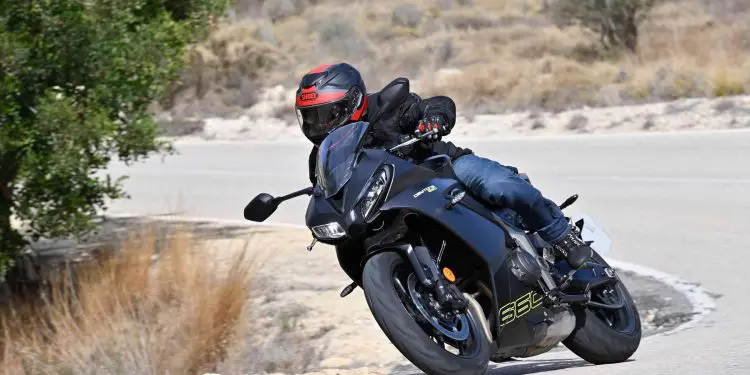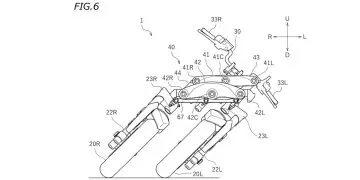EASY SPORTS BIKE
Together, the Tiger Sport and Trident have already sold more than 40,000 units in just over three years, models that have brought new riders to the brand, mostly young and also female riders. With a solid foundation established, Triumph invested wisely in introducing another model to the market, in this case in the segment of affordable intermediate sports bikes, where the four Japanese manufacturers already compete, along with Aprilia.
In a segment where performance matters but there is much more to it, starting with a pleasant and fun performance in daily commutes. The Daytona 660 features the same engine as the mentioned models but improved, making it more powerful and with more torque than the naked version, reaching 95 horsepower. It has new internal components and various improvements have been made, including the first two gear ratios being longer than the naked version, while the final drive is slightly longer. It also features a slipper clutch, although the quickshifter is optional on this model.
In this model, we also find three riding modes, Sport, Road, and Rain, on a bike that also has traction control, although without IMU, meaning a simpler traction control system that serves the model’s purposes. It is a sports bike, yes, but an easy sports bike, comfortable, ideal for the road although it can also easily handle some track days, so it aims to be a very versatile bike and that’s what we found on the roads around Benidorm.
MORE NUMBERS
Facing the naked Trident, the engine gained 17% power and the “redline” moved further away, to 12,650 rotations. The maximum torque value also increased to 69 Nm (9% more) and 80% of this is available in a large part of the rev range (between 3,125 and 11,750 rpm), which is remarkable and will benefit versatility. To achieve all this, the three-cylinder received new throttle bodies, a larger airbox, and various internal improvements, with a different crankshaft, new lower-friction pistons, different cylinder head, and a larger radiator, as well as the exhaust system also being revised. According to Triumph, it is the model in the segment that offers the best acceleration, but to prove this we will have to gather all the data! Throughout the day, we almost always rode in Sport mode, which offers a quicker and more assertive response between the throttle and the rear wheel, while traction control can be turned off but we kept it on as it works very well, providing the necessary safety without compromising fun.
CHASSIS (ALSO) IMPROVED
The chassis has also been modernized compared to the Trident 660. We find Showa suspensions on both axles, now with a 41 mm SFF-BP fork at the front, although only the rear mono-shock is adjustable, in the spring preload. The shock absorber also has a higher quality than the naked (even without being top of the range), and offers a balanced behavior. Overall, we liked the suspensions a lot, being comfortable but at the same time allowing a fairly fast pace on the road. At the front end, we now also find radial brake calipers, an evolution in the braking chapter, and in terms of tires, this model comes equipped with Michelin Power 6, which showed good grip capacity on dry asphalt. In terms of chassis, the highlight is the Showa Big Piston fork, which, even though it does not offer adjustments, is of high quality, just like the brakes, manufactured by Triumph themselves and have good feel and high power. The seat is placed at the correct height from the ground, and if you have been trying to figure out what frame this bike has… well, it’s the same tubular steel frame as the Trident, simply plastic covers have been placed on top that resemble a double aluminum beam!
Source: Motociclismo
The instrumentation is already known, simple and easy to navigate, with the main information.
Source: Motociclismo
A forquilha invertida dianteira oferece um bom desempenho, tal como o sistema de travagem em que as pinças de montagem radial foram desenvolvidas pela própria Triumph.
Source: Motociclismo
O condutor beneficia de um bom assento, confortável, enquanto o do passageiro é razoável e ao nível do que o segmento costuma apresentar.
Source: Motociclismo
The exhaust assumes the same position in this model, as does the shape of the swing arm. The Michelin tires are now more sporty than those found on the Trident and Tiger Sport 660.
Source: Motociclismo
The rear Showa mono-shock is the only one that offers adjustment (only in pre-load), but its performance convinced.
Source: Motociclismo
The 660 engine is now stronger compared to the Trident, especially at higher revs.
ON THE ROAD
In terms of riding sensations, we can start by talking about the riding position, which is clearly that of a sportbike, although not very uncomfortable. Triumph did not intend for this bike to be the most radical in the segment, but also did not want it to be “too comfortable” with the rider’s torso too upright, and we found a good balance between sportiness and comfort. The handlebars are not too low and only after many kilometers on mountain roads did we start to experience a slight wrist fatigue, but nothing major. And of course, if you are not used to bikes with handlebars, you may feel a bit awkward at first, especially when riding on very tight curves, so the ideal is to work a bit with your body in the curve, which also benefits the agility of the bike.
We liked the feeling of the accelerator, especially in Sport mode, and the engine is quite strong – linear as expected – and we can easily cruise at 60 km/h in sixth gear or push in each gear, noticing the power improvements compared to the Trident, so this engine is very fun like any three-cylinder and with a convincing sound. The suspension behavior is good, we also liked the braking, and the agility of the set is at a good level, not being a benchmark, but above all there is a lot of stability at any pace, on the highway or on a mountain road. The seat is also comfortable and the passenger can benefit from rigid handles that are among the many optional items from the brand. PROS AND CONS Regarding what we liked less, the aerodynamic protection is not very high because the screen is a bit narrow, so we catch some wind on the torso at higher speeds. We would also like the quickshifter to be standard on this model (even if the gearbox is smooth and precise) and the only optional we had on the bikes were the heated grips that were very handy in the morning. Ultimately, and in terms of dynamics, the only detail that I found less pleasing is the fact that the last two gears of the gearbox, fifth and sixth, are a bit short for those who like to ride fast on the highway, as the engine then runs at a higher rpm than we would like. We also liked the easy-to-read instrumentation, which can have connectivity and turn-by-turn navigation, for example, and we also appreciate the more than 30 accessories available for the Daytona 660. Aesthetic details, various protections, more comfort, luggage capacity, just choose. On the other hand, we were sorry to have tested a gray and black unit, as in our opinion the other decorations, in red and white, are much more attractive. In any case, this is a well-built bike, without major premium details compared to other models from the brand, but it does everything very well and is quite fun. We did 180 kilometers, with an average of 5 liters of gasoline per 100 and in general it is the bike we expected, being quite fun, versatile for a sporty bike and able to offer good driving moments. It is aimed at a predominantly young audience, coming from lower displacements and already accustomed to sport bikes, but it may also attract users from other segments. The price is at the level of the most direct competition, so here too this Daytona 660 presents the arguments to maintain the good image that the Trident and Tiger Sport 660 have left in various international markets.TRIUMPH DAYTONA 660
ENGINE 3-cylinder in-line, DOHC, 12 valves, liquid cooling
DISPLACEMENT 660 cc
POWER 95 hp (70 kw) @11,250 rpm
TORQUE 69 Nm @8,250 rpm
GEARBOX 6 speeds
FRAME steel tubular
TANK 14 liters
FRONT SUSPENSION 41 mm Showa Big Piston inverted fork, 110 mm travel
REAR SUSPENSION Showa mono-shock, 130 mm travel
FRONT BRAKE 2 310 mm discs, 4-piston radial calipers
REAR BRAKE 220 mm disc, 1-piston caliper
FRONT TIRE 120/70 ZR17
REAR TIRE 180/55 ZR17
WHEELBASE 1,425 mm
SEAT HEIGHT 810 mm
WEIGHT 201 kg
MSRP (from) 9,895 €







